As the vibrant colors of fall give way to the more subtle hues of winter, tree bark becomes a focal point in the forested landscape. The splendid contrasts of bark are highlighted by the low-riding winter sun – the white, curly strips of paper birch juxtapose with the dark, burnt cornflake scales on black cherry; the furrowed ski track patterns on the red oaks complement the smooth, bear-scarred bark of American beech.
In the Northeast, one can encounter 67 native and naturalized tree species, each with its own distinctive bark that often changes as trees mature. Spend a contemplative afternoon in the woods, and you might begin to wonder where all this diversity comes from. Why do species such as American beech maintain smooth, unbroken bark for their entire lifespans (if they avoid the ravages of beech bark disease), while the bark of northern red oak, black cherry, and most other species in this region cracks and thickens over time? The gleaming white trunks of paper birch are easy to recognize – but why are they so different from their gray and brown neighbors?
These questions are a great entry point into the world of bark ecology. Drought, temperature, fire, growing seasons, and interactions with other organisms all influence bark characteristics. But there are more subtle factors at play here as well, including physiological adaptations that go back millions of years.
Bark Structure
To understand why different trees display different styles of bark, we must first understand the inner workings of a tree. The term “bark” is often used to describe only the corky, visible outer surface of trunks and branches. In botanical terms, though, bark includes the entire, multi-layered shell of a tree that can be detached from the wood. That is, everything outside a thin ring of tissue called the vascular cambium. Cells divide and grow in the vascular cambium layer, producing a ring of wood to the inside and a layer of bark tissue, called the active phloem, to the outside. The active phloem transports sugars and nutrients throughout the tree, and is typically hidden from view, beneath the outer bark.
Outside the active phloem, trees have three additional bark layers, collectively called the periderm. You may need a scalpel and a microscope to find the first two layers, which are quite thin and also hidden from view. The inner layer – the cork skin – usually contains chlorophyll and does some photosynthesizing. The middle, cork cambium layer facilitates cell growth. The third, outer layer is made up of cork cells that die soon after they mature. This cork layer protects the tree from infection, infestation, and drying out. The smooth, unbroken outer bark that all trees start out with is this cork layer of the periderm.
As a tree grows, its wood thickens and pushes out against the bark that surrounds it. The different ways in which the outer bark adapts to this pressure is what gives each species its distinctive appearance. Some species maintain their original outer layers (the initial periderm) for their entire lives. In such cases, the outer bark expands to match the growth of the wood beneath it, and remains unbroken. On the smooth bark of beech trees, for instance, you can still decipher decades-old graffiti.
In most northeastern species, however, pressure from the faster-growing wood soon causes the initial periderm to split like a tight pair of jeans. When the initial periderm breaks, a new layer of active periderm forms to the inside. This new periderm usually forms in overlapping sections that vary in shape, size, and thickness according to species. Any cells trapped outside the active periderm become isolated and die. This process can repeat itself as a tree grows. Alternating layers of old periderm and dead phloem form the thick, craggy, flakey, outer bark that is found on most mature trees. Botanists call this protective outer bark the rhytidome, from the Greek rhytidoma, for wrinkle.
In each tree species, the bark’s appearance is determined by the shape of the overlapping sections of periderm, the type of connective tissue, and the rate at which layers of bark break apart. In black cherry, for example, the scales correspond to the size and shape of the periderm sections, which break apart from each other. In species such as northern red oak, sections of outer bark stay connected to form thick, vertical ridges.
Thick or Thin?
It’s impossible not to notice how some mature tree species, like black oak, have remarkably thick bark, while others, like beech, do not. Thick outer bark is generally a good investment, since it better protects a tree from wounds and provides more thermal protection. The outer bark’s air-filled cells function much like in home insulation, keeping the inside warmer or cooler than the outside. Ridges, scales, and vertical strips can function as radiator fins, dramatically increasing the outer surface area and helping to maintain a more even temperature. Contoured barks also hold moisture, which slows the transfer of heat through the outer bark.
Thick bark is especially important for fire protection. For example, black oak, which typically grows in drier, more fireprone habitat than any other species in the red oak group, develops thick bark earlier than any of these relatives. The outer bark of pitch pine, the most fire-adapted species in this region, thickens while the trees are still young and develops into deep, corky blocks that allow it to grow in dry habitats on rocky summits and sand plain forests that are susceptible to fire.
Fire is not the only thermal threat to trees; rapid temperature changes can also damage or kill sections of bark. In winter, for example, direct sunlight can warm bark to temperatures much higher than the surrounding air. When the sun sets and temperatures plummet, the rapidly cooling bark can crack as it contracts.
With all the protective advantages of thick bark, why does the bark of some species in our region remain thin? As well as requiring less effort to produce, a major advantage of thin bark is the increased ability to photosynthesize. Scraping away the outer bark on a twig or young branch reveals the thin, surprisingly green cork skin. This layer can perform, to a lesser degree, the same photosynthesis as leaves. Levels of energy production are highest on newer growth, where up to half of available sunlight can penetrate the outer bark and reach this green layer.
Since thick bark blocks most or all sunlight from reaching the cork skin, photosynthesis levels are usually much higher on species that maintain thin bark on their trunk and branches. Energy produced by bark photosynthesis is thought to support regular cell maintenance in the trunk and branches and can help trees recover from defoliation due to insects, storms, or severe drought. Bark photosynthesis has its heyday in early spring and late fall, when leaves do not shade the bark. But energy can also be produced in a seemingly dormant winter forest. Sunlight warms bark on the south- and southwest-facing sides of trunks and branches, making it possible for bark to photosynthesize even when air temperatures are below freezing.
Thin bark also helps thwart the mosses, lichens, and algae (collectively called epiphytes) that grow on trees and sometimes become a nuisance. Epiphytes can block sunlight, thus preventing efficient photosynthesis. They can also absorb heat, which increases a tree’s risk of damage from temperature changes. Beech developed smooth bark, which is difficult for epiphytes to gain a foothold on, because it evolved in tropical climates where epiphytes can amass in such large numbers that they break branches or pull down trunks; it maintained this trait as it migrated to cooler climates. Some trees, like paper birch, feature strips of bark that peel away from the trunk and take with them any light-blocking epiphytes that may have become established there. This peeling process also keeps lenticels, which are vital to bark photosynthesis, from becoming blocked.
Bark Defenses
Like the exterior walls of a house, outer bark not only regulates temperature, it also protects against intruders. In general, thin-barked species like American beech are easier to penetrate than species with thick bark, like northern red oak. But bark of any thickness has weak spots at lenticels, at cracks and furrows, and at branch junctions, where wrinkles bring the inner bark closer to the surface. Wounds in the outer bark open pathways for invaders such as fungi, bacteria, and insects, but in most cases the bark’s chemical and structural defenses can overcome infections and infestations.
Resins in conifers (which give species like balsam fir their pleasing smell) and the gums in black cherry bark repel insects and infectious agents, seal small wounds to prevent desiccation and infection, and trap insects. Black cherry bark also contains hydrocyanic acid, which gives off a sour, bitter-almond scent that wards off browsers, and has long been used by humans in cough medicines, as an expectorant, and to sooth sore throats.
Betulin, which whitens the bark of paper birch, deters gnawing animals, fungi, insects, and other invaders, helping to make up for the easy penetrability of this species’ thin outer bark. A host of medicinal properties are under investigation for betulin, including its potential as an anti-cancer drug. The inner bark of aspen and other members of the willow family contains salicin, a compound that deters bacteria, fungi, and insects. Salicin has long been used by humans as a pain reliever, and is the precursor of synthetically produced aspirin.
Structural mechanisms also defend a tree against infection and infestation, and can alter the appearance of bark in the process. Fungi that breach the outer bark, for example, can be walled off, or compartmentalized. This action contains the infection, but it also kills sections of bark by blocking the incoming flow of water and nutrients. The resulting small areas of discolored, sunken, or cracked bark are called annual cankers. Perennial cankers form when fungi that were initially compartmentalized overcome this defense by continuing to grow while the tree is dormant, or by colonizing the wood beneath the bark and bypassing the blockade. This cycle of incursion and walling off can repeat year after year, causing sections of bark to crack, break apart, and eventually separate from the trunk.
Some structural responses cause visible changes in the outer bark that help with tree identification. In this region, the perennial target canker – a series of concentric cracks in the outer bark – is found exclusively on red maple, though not on every tree. The circular cracks mark the cycles of the disease’s progress and the tree’s subsequent compartmentalization. Neither the tree nor the fungus seems to gain the upper hand, and this competition can continue year after year.
If an infection spreads around the circumference of the trunk, the resulting cankers can girdle and kill the tree. In the early 1900s, infections of this magnitude, caused by a nonnative fungus, nearly eliminated American chestnut.
Even when an infection or infestation is controlled, a tree must contend with a breach in the protective outer bark – like a broken window in a house – that other invaders could exploit. The inner bark generates cork to surround a wound, and can close small openings and narrow or close large gaps over time. Eastern hemlock is the only species in this region that produces wound cork in annual increments that you can count – like rings of wood – to determine a wound’s age.
Despite its multiple chemical and structural defenses, bark can’t protect trees from all attackers, especially introduced organisms for which a species has no evolved resistance. Beech bark disease illustrates the domino effect that can be initiated by a simple wound. The thin bark of American beech provides many advantages, but this species has no defense against the beech scale, a tiny insect smaller than the head of a pin, accidentally introduced from Europe in the 1800s. When these insects penetrate the bark to feed on sap, they chemically alter the bark in a way that allows a fungus to invade at a later time. A tree’s efforts to compartmentalize these infections typically fail. The resulting perennial cankers, which render the trunk and branches almost unrecognizable as beech, facilitate secondary infections and insect infestations that most often lead to the death of the tree.
Not all associations between bark and other organisms are parasitic. Some bark-inhabiting fungi and bacteria are thought to survive solely on exudates from their host, and do no harm. Other fungi and bacteria defend their hosts by out-competing or preying upon canker-causing fungi. These beneficial organisms are often found near lenticels or other weak areas of bark where pathogens might gain entry. When tiny insects, such as springtails and bark-lice, inhabit bark and feed on mosses, lichens, and fungi growing there, they can benefit their host tree by attracting spiders, ants, and other predators that can help control populations of defoliating insects.
At any given moment in your local forests, there are thousands of interactions between bark and the environment. We can’t easily see most of them, but visible features of bark hint at this invisible interplay. On a winter hike you might spy the luminous, whitebarked branches of a sycamore tree and imagine bark photosynthesis cranking out a little supplemental energy. Or conversely, you might feel kinship with an eastern hemlock – its multi-layered bark providing the same hedge against the winter chill as your multi-layered clothing.
Take some time to look at bark up close. Notice the resin blisters on balsam fir, the patchwork of thick plates on mature black birch, the way poplar bark changes so dramatically as the trees age. Perhaps you will be willing to strip off your gloves in the cold and get your hands on some bark – you might compare the smooth surface of a beech trunk with the rough ridges of a red oak, or notice the multiple layers of scales on a black cherry. At the very least, you will find that the world of bark is more than just a monotonous blur of browns and grays. To a tree, it’s a complex world of function; to an observer, it’s a source of beauty that shows itself best against the contrast of snowy winter woods.


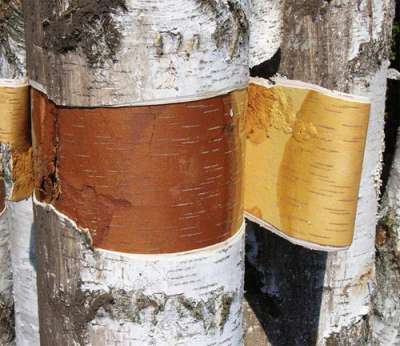
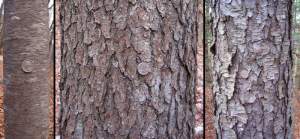

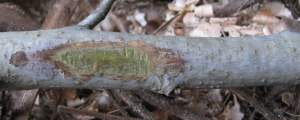
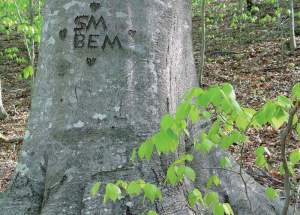

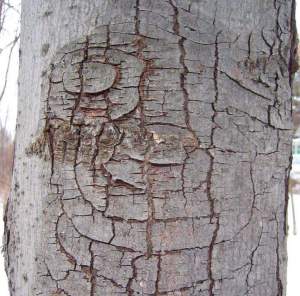
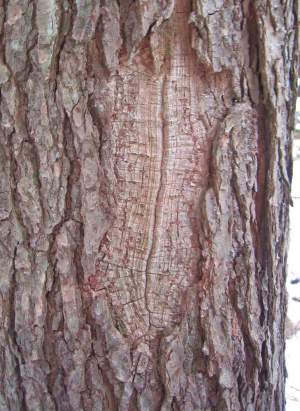
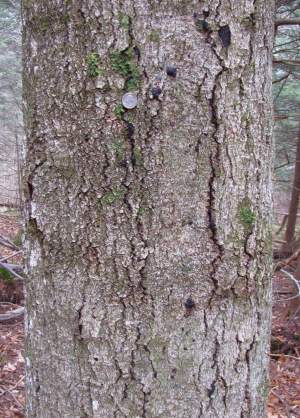
Discussion *